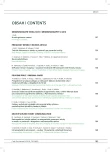Unusual Clinical Picture in Migraine – Case Reports
Authors:
R. Kotas 1; J. Kastner 2; V. Amblerová 1; J. Rokytová 1; H. Vacovská 1; J. Polívka 1; J. Kobr 3; A. Malán 4
Authors‘ workplace:
FN Plzeň
Neurologická klinika LF UK v Plzni
1; FN Plzeň
Radiodiagnostická klinika LF UK v Plzni
2; FN Plzeň
Dětská klinika LF UK v Plzni
3; FN Plzeň
Oddělení nukleární medicíny
4
Published in:
Cesk Slov Neurol N 2010; 73/106(2): 178-186
Category:
Case Report
Overview
This paper deals with two unusual clinical pictures of migraine. In the first case report, a 10‑year-old boy suffered from an attack of hemiplegic migraine with headache and left-sided hemiplegia with persistent aura without infarction, and recovered almost completely within 6 months of onset. Repeated conventional magnetic resonance imaging revealed no structural lesion of the brain, merely a subsiding light hypoperfusion in the frontal precentral regions bilaterally evident in perfusion‑weighted imaging. Findings in diffusion-weighted imaging and ADC maps were repeatedly normal. Examination of cerebral blood flow with single proton emission computed tomography was repeatedly normal. In the second case report, a 14‑year‑old boy suffered from a severe attack of migraine accompanied by delirium. Subarachnoid haemorrhage, meningitis and other structural lesions of the CNS were ruled out, while a toxicological examination, including alcohol, proved normal. The patient recovered within 12 hours.
Key words:
hemiplegic migraine – persistent aura without infarction – migraine with delirium
Sources
1. Headache Classification Subcommittee of International Headache Society. The International Classification of Headache Disorders: 2nd Edition. Cephalalgia 2004; 24 (Suppl 1): 1–160.
2. Agostoni E, Aliprandi A. The complications of migraine with aura. Neurol Sci 2006; 27 (Suppl 2): S91–S95.
3. San‑Juan OD, Zermeno PF. Migraine with persistent aura in a Mexican patient: case report and review of the literature. Cephalalgia 2007; 27(5): 456–460.
4. Jager HR, Giffin NJ, Goadsby PJ. Diffusion‑ and perfusion‑weighted MR imaging in persistent migrainous visual disturbances. Cephalalgia 2005; 25(5): 323–332.
5. Relja G, Granato A, Ukmar M, Ferretti G, Antonello RM, Zorzon M. Persistent aura without infarction: description of the first case studied with both brain SPECT and perfusion MRI. Cephalalgia 2005; 25(1): 56–59.
6. Liu, Schatz NJ, Galetta SL, Volge NJ, Skobieranda F, Kosmorski GS. Persistent positive visual phenomena in migraine. Neurology 1995; 45(4): 664–668.
7. Chen WT, Fuh JL, Lu SR, Wang SJ. Persistent migrainous visual phenomena might be responsive to lamotrigine. Headache 2001; 41(8): 823–825.
8. Lindahl AJ, Allder S, Jefferson D, Moody A, Martel A. Prolonged hemiplegic migraine associated with unilateral hyperperfusion on perfusion weighted magnetic resonance imaging. J Neurol Neurosurg Psychiatry 2002; 73(2): 202–203.
9. Masuzaki M, Utsunomiya H, Yasumoto S, Mitsudome A. A case of hemiplegic migraine in childhood: transient unilateral hyperperfusion revealed by perfusion MR imaging and MR angiography. AJNR Am J Neuroradiol 2001; 22(9): 1795–1797.
10. Barbour PJ, Castaldo JE, Shoemaker EI. Hemiplegic migraine during pregnancy: unusual magnetic resonance appearance with SPECT scan correlation. Headache 2001; 41(3): 310–316.
11. Chabriat H, Vahedi K, Clark CA, Poupon C, Ducros A, Denier C et al. Decreased hemispheric water mobility in hemiplegic migraine related to mutation of CACNA1A gene. Neurology 2000; 54(2): 510–512.
12. Eikermann‑Haerter K, Moskowitz M. Pathophysiology of Aura. In: Silberstein SD, Lipton RB, Dodick DW (eds). Wolff’s Headache and Other Head Pain. New York: Oxford University Press 2008: 121–123.
13. Olesen J, Larsen B, Lauritzen M. Focal hyperemia followed by spreading oligemia and impaired activation of rCBF in classic migraine. Ann Neurol 1981; 9(4): 344–352.
14. Lauritzen M, Olesen J. Regional cerebral blood flow during migraine attacks by Xenon 133 Inhalation and Emission Tomography. Brain 1984; 107(2): 447–461.
15. Kotas R, Záhlava J, Kastner J. Zobrazovací metody u migrény (SPECT, angiografie, MRI). Bolest 1998; 1(4): 105–111.
16. Woods RP, Iacoboni M, Mazziotta JC. Brief report: bilateral spreading hypoperfusion during spontaneous migraine headache. N Engl J Med 1994; 331(25): 1689–1692.
17. Geraud G, Denuelle M, Fabre N, Payoux P, Chollet F.Positron emission tomographic studies of migraine. Rev Neurol (Paris) 2005; 161(6–7): 666–670.
18. Andersen AR, Friberg L, Olsen TS, Olesen J. Delayed hyperemia following hypoperfusion in classic migraine: Single photon emission computed tomographic demonstration. Arch Neurol 1988; 45(2): 154–159.
19. Cao Y, Autiora S, Vikingstad E, Welch KM. Functional MRI (fMRI) of visually triggered headache: stimulation, suppression and propagation of the bold effect. J Cereb Blood Flow Metab 1997; 17 (Suppl): S176.
20. Moskowitz MA. The neurobiology of vascular head pain. Ann Neurol 1984; 16(2): 157–168.
21. Almeida RF, Leão IAT, Gomes JBL, da Silva AA jr, Teixeira AL. Migraine with persistent visual aura: response to furosemide. Clinics (Sao Paulo) 2009; 64(4): 375–376.
22. Davidoff RA. Migraine: manifestations, pathogenesis and management. Philadelphia: F. A. Davis Company 1995.
23. Lance JW, Goadsby PJ. Mechanisms and management of headache. 6th ed. Oxford: Butterworth Heinemann 1998.
Labels
Paediatric neurology Neurosurgery NeurologyArticle was published in
Czech and Slovak Neurology and Neurosurgery

2010 Issue 2
Most read in this issue
- Huntington’s Disease
- Unusual Clinical Picture in Migraine – Case Reports
- Retrospective Study of Magnetic Resonance Imaging of the Brain and Spine in Neuromyelitis Optica
- Neurorehabilitation
